

-1. Radiation contamination leaves Fukushima schools unable to drain pool water. Effect of contaminated soil on food chain sparks fears. Six months after the nuclear meltdowns in Fukushima Prefecture, the public’s awareness of the threat posed by radiation is entering a new phase: the realization that the biggest danger now and in the future is from contaminated soil.

Notification You’ve reached your story limit as a non-registered user. To read more, please sign up or log in via one of the services below. This will give you access to 15 additional stories this month. Citizen group tracks down Japan's radiation - Asia-Pacific. The aftermath of the Fukushima Daiichi nuclear crisis has been marked by an outcry in Japan over radiation leaks, contaminated food and a government unable to put the public's fears to rest.
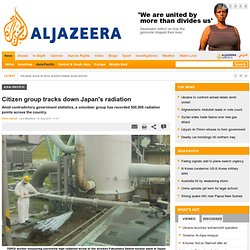
Perhaps the most worrying aspect of the meltdown that resulted from March's earthquake–triggered disaster, activists and citizens have said, is the uncertainty that has ensued. In the months since the catastrophe, the Japanese government, its nuclear watchdogs and Tokyo Electric Power Company (TEPCO), have provided differing, confusing, and at times contradictory, information on critical health issues. Fed up with indefinite data, a group of 50 volunteers decided to take matters, and Geiger counters, into their own hands. In April, an independent network of like-minded individuals in the Japan and United States banded together to form Safecast and began an ongoing crusade to record and publish accurate radiation levels around Japan.
Fukushima radiation alarms doctors - Features. Scientists and doctors are calling for a new national policy in Japan that mandates the testing of food, soil, water, and the air for radioactivity still being emitted from Fukushima's heavily damaged Daiichi nuclear power plant.
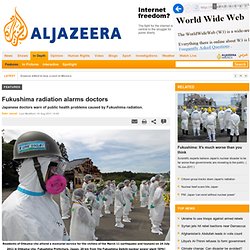
"How much radioactive materials have been released from the plant? " asked Dr Tatsuhiko Kodama, a professor at the Research Centre for Advanced Science and Technology and Director of the University of Tokyo's Radioisotope Centre, in a July 27 speech to the Committee of Health, Labour and Welfare at Japan's House of Representatives. "The government and TEPCO have not reported the total amount of the released radioactivity yet," said Kodama, who believes things are far worse than even the recent detection of extremely high radiation levels at the plant.
Kodama's centre, using 27 facilities to measure radiation across the country, has been closely monitoring the situation at Fukushima - and their findings are alarming. Public hoarding old rice over fallout fears. Consumers are starting to hoard last year’s rice over concerns the next crops may be contaminated with radioactive materials released from the Fukushima No. 1 power plant, retailers said Friday.
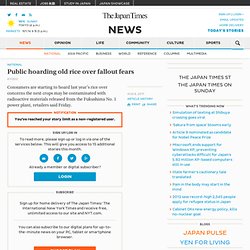
Notification You’ve reached your story limit as a non-registered user. To read more, please sign up or log in via one of the services below. This will give you access to 15 additional stories this month. Japan tsunami: Long-term radiation concerns in Fukushima. Please support our site by enabling javascript to view ads.

TOKYO, Japan — The tsunami advisory imposed after a magnitude 6.8 earthquake struck Japan's northeast coast on Friday afternoon served as a reminder that the country is still prone to strong aftershocks. Although the warning was quickly lifted, it refocused attention on the Fukushima Daiichi nuclear power plant, which is still releasing radiation more than five months after it was wrecked by an earthquake and tsunami. Thousands of Sunflowers Planted in Fukushima to Combat Radiation in Full Bloom (PHOTOS) Thousands of sunflowers planted at Joenji temple in Fukushima, northern Japan, to help fight the radiation from Fukushima Daiichi Nuclear Plant, have blossomed.

A volunteer group Make A Wish Upon Flowers had planted the sunflowers in the temple’s vicinity and had urged the public to plant sunflowers to prevent spread of radiation through soil as well as help decontaminate soil from radioactive materials. Though Japanese scientists are carrying out tests to prove their usefulness in fighting radiation, sunflowers were also used near Chernobyl to extract radioactive Cesium (Cs) from contaminated ponds nearby after the 1986 nuclear accident, Reuters reported. In early July, the Fukushima Network for Saving Children from Radiation and five other non-governmental organizations surveyed four locations in Fukushima city, outside the nuclear evacuation zone, and found soil radiation above levels.
Zone Near Fukushima Daiichi May Be Off Limits for Decades. Areas near Japan nuclear plant may be off limits for decades. Tokyo Rising : A Documentary on 3/11. A gorgeous informative short documentary about 3/11 in Japan debuted today via VBS.TV and Palladium Boots featuring Pharrell exploring the country and visiting artists and having them share their thoughts, feelings and creative work.

“Tokyo faces a new reality after the tragedy of 3/11. While persistent challenges still lay ahead, the city’s creative class is hell-bent on making sure that their hometown thrives. Innovative and resilient, they are defining the future of Tokyo on their own terms. Tweet to Japan's Prime Minister, @JPN_pmo for independent research. The Japanese Government is blocking us from carrying out crucial radiation monitoring within the country's 12 mile territorial waters.

Tell Japan's Prime Minister that independent monitoring of radioactive ocean pollution is in everyone's best interest. If you prefer to write your own Twitter message: Messages should go to @JPN_PMOPlease include the hashtag #rw-japan so we can keep track of how many people send messages.Please be polite! KaressU News. Fukushima radiation fears: children near nuclear plant to be given monitors. Tens of thousands of children living near the Fukushima Daiichi nuclear power plant are to be given personal radiation monitors, as concern grows over the long-term health effects of exposure to radiation. Dosimeters will be given to 34,000 children aged between four and 15 living in Fukushima city, 45 miles from the plant, after abnormally high radiation readings were recorded in the area.
The risks posed by radiation from the world's worst nuclear accident since Chernobyl have already driven 80,000 people from homes within 12 miles of the plant. Many of the child evacuees from communities that now lie empty attend schools in Fukushima, a city of 300,000 people. Local authorities have provided monitors to schools outside the exclusion zone, but this is the first time they have been supplied to individual pupils. Data from the dosimeters will be analysed to assess the risks posed by cumulative radiation exposure. Fukushima pensioner army waits for call-up to frontline duties. So far, about 9,000 workers have been involved in the four-month operation to stabilise the Fukushima Daiichi nuclear power plant, where three of six reactors experienced meltdown in the aftermath of the 11 March tsunami.
If Yasuteru Yamada gets his way, the Fukushima workforce of the future will include a band of fearless pensioners calling themselves the skilled veterans corps. This month the retired engineer for Sumitomo Metal Industries, one of the world's top steel manufacturers, is expected to visit the plant with four colleagues to carry out preliminary inspections. They propose to help design a replacement for the destroyed reactor cooling system. The 72-year-old graduate of Tokyo University will survey the damage and, pending final approval from the government and Tepco, the plant operator, call on hundreds of registered volunteers, all over 60, with expertise in a range of disciplines. As of last week, 430 people had volunteered, according to the group's website. Experts say Fukushima 'worse' than Chernobyl - Asia-pacific. 'Radiation turns up in all kinds of food products in Japan' Japanese Rice’s Radiation Levels Prompt More Tests.
Cesium fallout map illustrates Kanto levels. First Time: Gov’t admits Plutonium-238 detected in locations far from Fukushima plant « ENENEWS.COM. BUSTED: Japan 'scared' of telling truth to Fukushima evacuees 9/28/11. Highly Radioactive Rice, Hydrogen Checks, Burning Radioactive Waste Fukushima Update 9/25/11. Thyroid gland irregularities found in young evacuees from Fukushima. International nuclear inspectors arrive in Fukushima. Radioactive ash causes Kashiwa incinerators to shut down. National ( ) Authorities in Kashiwa City, Chiba Prefecture, said Tuesday that levels of radioactive cesium found in ash from garbage disposal facilities can no longer be contained and stored, causing garbage incineration plants to be temporarily shut down.
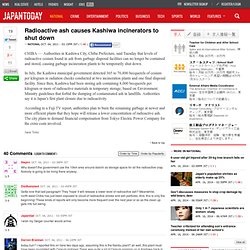
In July, the Kashiwa municipal government detected 365 to 70,800 becquerels of cesium per kilogram in radiation checks conducted at two incineration plants and one final disposal facility. News: Actual Fukushima worker warns to get out of Japan before Spring comes. Posted by Mochizuki on October 5th, 2011 · 12 Comments Children have already started to have thyroid problems “even though they evacuated”.
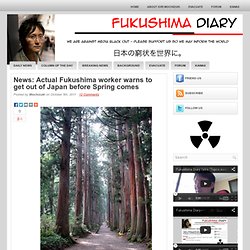
It was assumed to take 5 years but the symptoms are showing up much faster than we ever thought. Now it’s known that most part of the plume is stuck to the trees or soil in the mountains, where you can hardly decontaminate. News: Helicopter monitoring data is published. Posted by Mochizuki on October 6th, 2011 · 9 Comments Ministry of Education, Culture, Sports, Science and Technology quit measuring plutonium but they mistakenly published the contamination map of Tokyo, Kanagawa and north Kanto area. It was measured by a helicopter. Page 3 Radiation level of Tokyo (1m from the ground) Page 4 Cesium 134+137 on the ground in Tokyo. News: Do you still ignore the fact? Posted by Mochizuki on October 9th, 2011 · 40 Comments Plants’ mutation are observed everywhere, and the cases are increasing.
Persimmon 10/X/2011 @Tochigi Sweet potato 9/30/2011 @Funabashi Chiba. Fukushima's radioactive sea contamination lingers - environment - 30 September 2011. Global resources needed to combat radiation levels. Radiation in Japan: Hot spots and blind spots. Japan: the psychological impact of Fukushima nuclear catastrophe. For Japanese, Fukushima spells fear, MARK MACKINNON,TOKYO—Globe and Mail, Oct. 12, 2011 The Fukushima fallout has now spread well beyond what can be measured with a Geiger counter. In the minds of many consumers, Fukushima prefecture – which, at almost 14,000 square kilometres is bigger than Lebanon or Jamaica – and the Fukushima Daiichi nuclear plant are one and the same. Though the Japanese government has evacuated only a 20-kilometre radius around the plant, many inside and outside Japan treat the entire region as though it’s contaminated, unsure of what to make of shifting official assessments of the situation.
Markwillacy: One of the last of the sun... Japan’s radioactive seafood problem. Two boys found with high internal radiation exposure. Kashiwa hot spot linked to Fukushima. Japan cities face growing radioactive ash, troubles ahead. Fallout forensics hike radiation toll. Fukushima Plant Released Record Amount of Radiation Into Sea. Fukushima Debris on Course to Hit U.S. 'Mystery man' gave leads on hot spots in Setagaya Ward.
A mystery man's untiring survey with a dosimeter led to discoveries of alarming levels of radiation in Tokyo's Setagaya Ward, which made headlines after authorities confirmed them. The man, armed with the dosimeter he bought for 130,000 yen ($1,700) in September, combs through the ward on a bicycle and releases results on his Twitter account, "n0ri_tiki". (0=zero) The tipster, who appears to be around 40 years old, would not disclose his identity, except to say that he lives in the ward. He was wearing sunglasses when he met Asahi Shimbun reporters on Oct. 29. Japan MP Yasuhiro Sonoda drinks Fukushima water. 1 November 2011Last updated at 09:36 Japan cabinet office spokesman Yasuhiro Sonoda looked nervous A Japanese official has drunk water collected from the quake-hit Fukushima Daiichi nuclear plant, after reporters challenged him to prove it was safe.
Yasuhiro Sonoda appeared nervous and his hands shook as he downed a glass during a televised news conference. Fukushima residents' urine now radioactive. Forgotten radioactive materials cropping up in wake of Fukushima nuclear crisis. Fukushima Disaster Effects on United States Public Health. Study finds parts of Japan no longer safe for farming. Japan finds radioactive cesium in rice - World. New radiation scare for rice in Japan. Fukushima rice banned by Japan. Japan faces years of food contamination fears. Cesium found in milk powder made by Japan's Meiji. Fukushima fallout fears over Japan farms. Les Japonaises unies contre les mensonges d'Etat. Tokyo Districts Expand Radiation Checks After High Readings.
Low-level radiation detected in Fukushima students. Radioactive cesium blankets 8% of Japan's land area. Fukushima children forced to drink radioactive milk at school. Japanese Seniors: Send Us To Damaged Nuclear Plant. Kan reveals Tokyo nuclear evacuation plans - ABC Melbourne - Australian Broadcasting Corporation. Greenpeace: Fukushima schools unsafe after clean-up. Food Contamination Set to Rise as Japan Fights Radiation Crisis at Reactor.